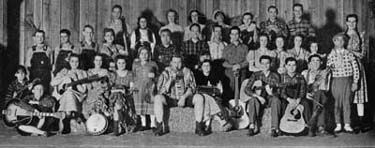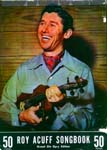Renfro Valley Barn Dance
The Renfro Valley Barn Dance started on WLW from the Cincinnati
Music Hall on October 9, 1937. After a successful year there, the
show was moved to Dayton where it was staged at the Memorial Auditorium.
It was successful there, too. But John Lair had a dream about what
he thought a Barn Dance show should be like. So, on November 4, 1939,
the show took up residence in the famous big barn in Renfro Valley,
built just for the show.

And it turned into what might be the forerunner of theme park
entertainment because the Renfro Valley Barn Dance was more than
just a show. On the grounds, there was a place for guests to stay.
A restaurant with typical southern cooking. A souvenir store where
the stuff they sold, much of it made right there in Renfro Valley.
Mr. Lair's thought was to put the emphasis on 'realism' and less on
'showmanship'. He sold his idea so well, that folks like Red Foley
and Whitey Ford (the Duke of Paducah) signed on, we think as investors, too.
The book by Dick Perry, "Not Just a Sound: The Story of WLW" mentioned that
the Renfro Valley Barn Dance was run by the trio of Lair, Foley and Ford. If
you read the souvenir publication 'Renfro Valley Keepsake' - you see John's
love of the area he grew up in. The booklet does more than promote the show. It
provides the history of the Renfro Valley area and places of interest for those
who visit.
And he began to build the roster for the show. He got Homer "Slim"
Miller to sign on. In fact, John Lair had told Slim of his dream long
before it became reality and promised him that he would get
to play the first song on the show. Slim stuck around about 10 years and
got his chance. Mr. Lair pushed Lily May Ledford to put together an all-girl fiddle band, which
would be the first of its kind back then. Milly and Dolly Good were
talked into becoming a harmony team again. For comedy, he got
Margaret Lillie and Harry Mullins to team up as A'nt Idy and Little
Clifford.

The show opened up in the country side in Renfro Valley, despite all
the critics saying no way it was going to work and were waiting for it
to fail. But from day one, the crowds came and was a success. Perhaps
John heard that voice - build it, they will come. A story that movies are
made of. And then they said, oh, it'll end in a couple weeks after the
novelty wears off. But what happened? The crowds kept getting bigger
and bigger. They thought no one would drive a 100 miles to the country side
to see a barn dance. But the critics ate a bit of crow.
Even during winter months, the crowds kept coming. From all distances. Sometimes
they'd count license plates from 15 states at the Barn Dance. Sometimes
the folks from Ohio and Indiana outnumbered the folks from Kentucky,
but the local folks came, too.
The barn could only comfortably hold about 1,000 people. But the crowds
were such that it became necessary to hold as many as three shows each
Saturday to accomodate the demand. They wrote that on two occasions,
they had up to 5,000 people in attendance. Considering the roads and cars
back then, that might be a pretty good success and testament to the
entertainment that folks found in Renfro Valley.
Dwight Butcher was one of the emcees, usually handling the
second show duties. He sang tenor and played guitar and harmonica, too.
Master of Ceremonies was Gene Cobb, a bit of a comedian who could
do impersonations, dance and sing. John Lair was a bit of a workhorse
doing announcing work as well as planning the buildings, supervising
their construction, writing, producing, announcing and maintaining
his music libary collection, too.
One has to be impressed by the roster of talent that was a part
of this show. The roster reads of some of the legends of hillbilly
and country music. Red Foley and Whitey Ford early on as investors.
Jerry Byrd - the steel guitarist that many of us try to imitate but
never come close played here. Then there was a couple of fellows named
Jethro Burns and Homer Haynes - Homer and Jethro and look at their pictures
back then - almost looking too young to be performers.
Today, what John Lair had a vision and dream for, still lives on.
For you can still attend country music shows in Renfro Valley, Kentucky.
In fact, Renfro Valley claims that it is the country music capital of
Kentucky.
Trivia / Timeline Notes
- First broadcast at Cincinnati Music Hall, October 9, 1937
- Held at Dayton Memorial Auditorium for a year or so
- Moved to Rock County, KY to Renfro Valley on November 4, 1939
- Link to Renfro Valley - today
Credits & Sources
- Song and Picture Barn Dance Magazine No. 5 (Jan 1948);
Chicago, IL




